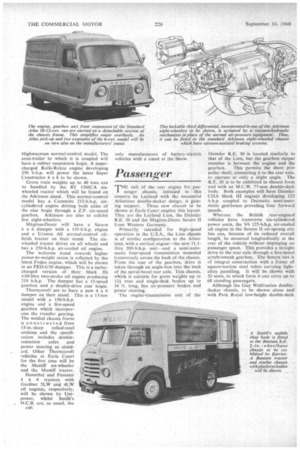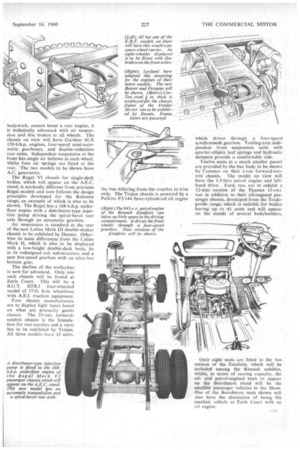Passenger
Page 136

Page 137

If you've noticed an error in this article please click here to report it so we can fix it.
THE cult of the rear engine for passenger chassis, initiated in this country by Leyland with the successful Atlantean double-decker design is gaining support. Three new chassis to be shown at Earls Court employ this layout. They are the Leyland Lion, the Daimler R.E. 30 and the Magirus-Deutz Saturn 11 from Western Germany.
Primarily intended for high-speed operation in the U.S.A., the Lion chassis is of similar configuration to the Atlantean, with a vertical engine—the new 11.1litre 200-b.h.p. unit—and a semi-automatic four-speed transmission mounted transversely across the back of the chaasis. From the rear of the gearbox, drive is taken through an angle-box into the back of the spiral-bevel rear axle. This chassis, which is suitable for gross weights up to 13* tons and single-deck 'bodies up to 34 ft. long, has air-pressure brakes and power steering.
The engine-transmission unit of the Daimler R.E. 30 is located similarly to that of the Lion, but. the gearbox output member is between the engine and the
gearbox. This permits the short propeller shaft, connecting it to the rear axle, to operate at only a slight angle. The R.E. 30 is to be exhibited in chassis form and with an M.C.W. 77-seat double-deck body. Both examples will have Daimler CD.6 Mark III engines developing 125 b.h.p. coupled to Daimatic semi-automatic gearboxes providing four forward speeds.
Whereas the British rear-engined vehicles have transverse six-cylindered power units, the V6 125-b.h.p. air-cooled oil engine in the Saturn II air-sprung city bus can, because of its reduced overall length, be mounted longitudinally at the rear of the vehicle without impinging on passenger space. This provides a straight drive to the rear axle through a five-speed synchromesh gearbox. The Saturn bus is of integral construction with a frame of square-section steel tubes carrying lightalloy panelling. It will be shown with 32 seats, in which form it can carry up to 68 standing passengers.
Although the Guy Wulfrunian doubledecker chassis, to be shown alone and with Park Royal low-height double-deck bodywork, cannot boast a rear engine, it is technically advanced with air suspension and disc brakes at all wheels. The chassis on view will have Gardner 6LX 150-b.h.p. engines, four-speed semi-automatic gearboxes, and double-reduction rear axles. Independent suspension at the front has single air bellows at each wheel, whilst four air springs are fitted at the rear. The two models to be shown have A.C. generators.
The Regal VI chassis for single-deck bodies, which will appear on the A.E.C. stand, is markedly different from previous Regal models and now follows the design principles developed for the Reliance range, an example of which is also to be shown. The Regal has a 168-b.h.p. underfloor engine with adistributor-type injection pump driving the spiral-bevel rear axle through an automatic gearbox.
Air suspension is standard at the rear of the new Loline Mark III double-decker chassis to be exhibited by Dennis. Otherwise its main differences from the Lolinc Mark II, which is also to be displayed with a low-height double-deck body, lie in its redesigned cab sub-structure and a new five-speed gearbox with an ultra-low bottom gear.
The decline of the trolleybus is now far advanced. Only one such chassis will be found at Earls Court. This will be a B.U.T. ETB.1 four-wheeled model of 17-ft. 6-in, wheelbase with A.E.I. traction equipment.
Four chassis manufacturers are to display light buses based on what are primarily goods chassis. The 25-cwt. forwardcontrol chassis is the foundation for two coaches and a rural bus to be exhibited by Trojan. All three models have 13 seats, the bus differing from the coaches in trim only. The Trojan chassis is powered by a Perkins P3/144 three-cylinclered oil engine which drives through a four-speed synchromesh gearbox. Trailing-arm independent front suspension units with quarter-elliptic leaf springs and hydraulic dampers provide a comfortable ride.
Twelve seats in a much smaller parcel are provided by the bus body to be shown by Commer on their 11-ton forward-control chassis. The model on view will have the 1.5-litre petrol engine and lefthand drive. Ford, too, are to exhibit a 12-seat version of the Thames 15-cwt. van in addition to their oil-engined passenger chassis, developed from the Trader goods range, which is suitable for bodies having up to 41 seats and will appear on the stands of several bodybuilders.
Only eight seats are fitted in the bus version of the Estafette, which will be included among the Renault exhibits, whilst, in terms of seating capacity, the oiland petrol-engined taxis to appear on the Beardmore stand will be the sthallist passenger vehicles in the Show. One Of the Beardmore taxis shown will also have the distinction of being the smallest vehicle at Earls Court with an oil engine.




































































































































































































































